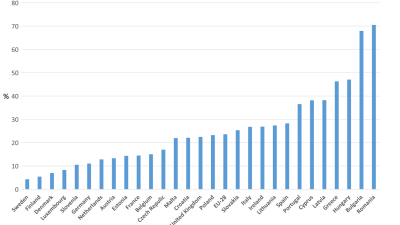Trends in China are the dominant factor in global inequality trends since the late 1980s, according to a study by academics at the Center for Global Development in Washington (USA). The paper proposes an alternative approach to measuring global inequality based on consumption patterns, which suggests that progress in reducing inequality has been slower than sometimes portrayed.
Key points
- A slow but steady rise in within-country inequality has in recent decades been largely offset by a gradual decline in between-country inequality. Since 2005 between-country inequality has been falling more quickly than before, and as a result total global inequality has also started to fall – quite quickly in the last few years.
- But there is a pronounced 'China effect' in the statistics. In the last 20-30 years, falls in total global inequality and between-country inequality, as well as rises in global within-country inequality, are all predominantly attributable to rising prosperity in China.
- Most of the ‘structural’ change in the distribution of global consumption is confined to the upper middle-income countries, notably China. If those countries are omitted from the calculations, the long-standing bipolar world of two highly differentiated clusters persists largely unchanged.
- Out of extra global consumption of $10 trillion from 1990 to 2010, an estimated 15 per cent went to the richest 1 per cent of the global population. At the other end of the distribution those under $2 a day in 1990 (53 per cent of the population at that time) collectively benefited from less than an eighth of the global consumption growth. And the 37 per cent of the world population on less than $1.25 a day in 1990 collectively benefited by little more than a twentieth of global growth.
Source: Peter Edward and Andy Sumner, The Geography of Inequality: Where and by How Much Has Income Distribution Changed since 1990?, Working Paper 341, Center for Global Development
Link: Paper



 PSE:UK is a major collaboration between the University of Bristol, Heriot-Watt University, The Open University, Queen's University Belfast, University of Glasgow and the University of York working with the National Centre for Social Research and the Northern Ireland Statistics and Research Agency. ESRC Grant RES-060-25-0052.
PSE:UK is a major collaboration between the University of Bristol, Heriot-Watt University, The Open University, Queen's University Belfast, University of Glasgow and the University of York working with the National Centre for Social Research and the Northern Ireland Statistics and Research Agency. ESRC Grant RES-060-25-0052.






